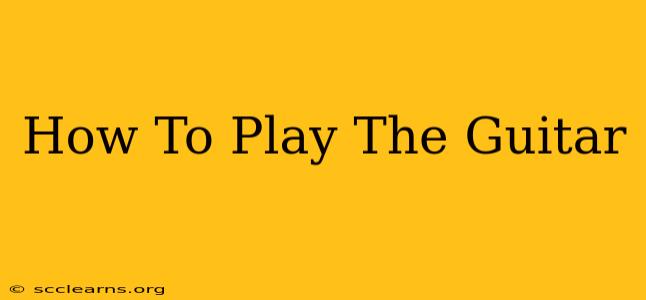So, you've decided to learn guitar? That's fantastic! The guitar is a rewarding instrument, capable of producing beautiful melodies and powerful rhythms. This comprehensive guide will walk you through the essential steps to get you started on your musical journey. Whether you dream of strumming campfire songs or shredding solos, this guide will provide the foundation you need.
Getting Started: Choosing Your Guitar and Essential Gear
Before you start learning chords, you'll need a guitar! There are several types to consider:
-
Acoustic Guitars: These are great for beginners due to their simpler mechanics. They don't require amplification and are perfect for practicing anywhere. Steel-string acoustics are common, but nylon-string classical guitars offer a softer sound and can be easier on the fingertips initially.
-
Electric Guitars: These require an amplifier and other gear, making them a more significant investment upfront. They offer a wide range of tones and are popular for rock, blues, and many other genres.
-
Choosing the Right Guitar: Consider your budget, musical preferences, and playing style. If you're unsure, visiting a local music store and trying out different guitars is highly recommended.
Beyond the guitar itself, you'll need a few essentials:
- Picks (Plectrums): Experiment with different thicknesses to find what feels comfortable.
- Tuner: A clip-on tuner is a convenient and affordable option to keep your guitar in tune. Learning to tune your guitar by ear is a valuable skill to develop later.
- Guitar Strap (for electric and some acoustic guitars): Essential for playing standing up.
- Case or Gig Bag: Protects your investment from damage.
Mastering Basic Chords: The Building Blocks of Guitar Playing
Learning basic chords is fundamental to playing the guitar. Start with these easy chords:
- G Major: A relatively straightforward chord to learn.
- C Major: Another essential and frequently used chord.
- D Major: A slightly more challenging chord but crucial for many songs.
- Em (E minor): Introduces the concept of minor chords, adding emotional depth to your playing.
- Am (A minor): Another common minor chord that pairs well with many major chords.
Tips for Learning Chords:
- Finger Placement: Use a finger placement chart or video tutorial for accurate positioning.
- Practice Regularly: Even short, consistent practice sessions are more effective than infrequent long ones.
- Listen Carefully: Pay attention to the sound you’re producing, aiming for a clear, ringing tone.
- Be Patient: Learning chords takes time and dedication. Don't get discouraged!
Strumming Patterns: Bringing Your Chords to Life
Once you've mastered a few chords, it's time to learn strumming patterns. Start with simple downstrokes and gradually incorporate upstrokes to create more complex rhythms. Here are a few basic patterns to try:
- Down-Down-Up-Down-Up: A common and versatile pattern.
- Down-Down-Down-Up: A simple pattern for beginners.
- Down-Up-Down-Up: A more rhythmic pattern.
Experiment with different strumming patterns and find what feels comfortable and sounds good to you. Remember to use a metronome to help improve your timing and rhythm.
Beyond the Basics: Expanding Your Guitar Skills
Once you've mastered the basics, there are countless possibilities for expanding your skills:
- Learning More Chords: Explore different chord types, such as seventh chords and barre chords.
- Fingerpicking: A more advanced technique that involves playing individual notes with your fingers.
- Scales and Music Theory: Understanding music theory will significantly improve your playing and songwriting.
- Guitar Tabs (Tablature): Tablature provides a visual representation of the music, making it easier to learn songs.
- Online Resources & Lessons: Utilize YouTube tutorials, online courses, and apps to accelerate your learning.
Practice Makes Perfect: Consistency is Key
Learning guitar is a journey, not a race. Consistent practice is the key to progress. Even 15-30 minutes of dedicated practice each day will yield significant results over time. Remember to be patient with yourself, celebrate your progress, and most importantly, have fun!
Learning to play the guitar is a rewarding experience that brings countless benefits, from creative expression to improved cognitive function. So grab your guitar, start practicing, and enjoy the journey of learning this wonderful instrument.

